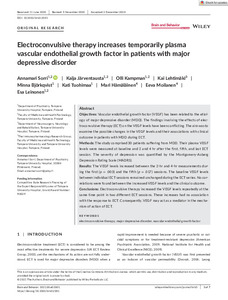Electroconvulsive therapy increases temporarily plasma vascular endothelial growth factor in patients with major depressive disorder
Sorri, Annamari; Järventausta, Kaija; Kampman, Olli; Lehtimäki, Kai; Björkqvist, Minna; Tuohimaa, Kati; Hämäläinen, Mari; Moilanen, Eeva; Leinonen, Esa (2021)
Sorri, Annamari
Järventausta, Kaija
Kampman, Olli
Lehtimäki, Kai
Björkqvist, Minna
Tuohimaa, Kati
Hämäläinen, Mari
Moilanen, Eeva
Leinonen, Esa
2021
Julkaisun pysyvä osoite on
https://urn.fi/URN:NBN:fi:tuni-202108276835
https://urn.fi/URN:NBN:fi:tuni-202108276835
Kuvaus
Peer reviewed
Tiivistelmä
Objectives: Vascular endothelial growth factor (VEGF) has been related to the etiology of major depressive disorder (MDD). The findings involving the effects of electroconvulsive therapy (ECT) on the VEGF levels have been conflicting. The aim was to examine the possible changes in the VEGF levels and their associations with clinical outcome in patients with MDD during ECT. Methods: The study comprised 30 patients suffering from MDD. Their plasma VEGF levels were measured at baseline and 2 and 4 hr after the first, fifth, and last ECT session. The severity of depression was quantified by the Montgomery-Asberg Depression Rating Scale (MADRS). Results: The VEGF levels increased between the 2-hr and 4-hr measurements during the first (p =.003) and the fifth (p =.017) sessions. The baseline VEGF levels between individual ECT sessions remained unchanged during the ECT series. No correlations were found between the increased VEGF levels and the clinical outcome. Conclusions: Electroconvulsive therapy increased the VEGF levels repeatedly at the same time point in two different ECT sessions. These increases had no association with the response to ECT. Consequently, VEGF may act as a mediator in the mechanism of action of ECT.
Kokoelmat
- TUNICRIS-julkaisut [16944]
